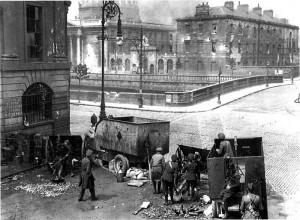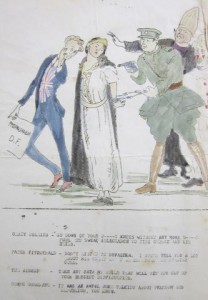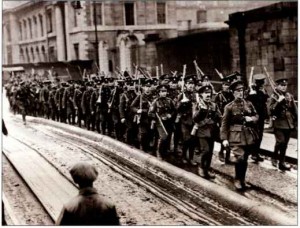British Military Involvement in the Irish Civil War

By John Dorney
In recent weeks, (November 2012) there has been a flurry of controversy over the recovery, in the Imperial War Museum Archives, of a memoir by a British artilleryman who claimed his howitzer fired the opening shots of the Irish Civil War.
Lance Bombardier Percy Creek, Royal Field Artillery,’s unpublished memoir, found by historian William Sheehan, recalled that his unit, stationed in Fermanagh – presumably to take part in the fighting there between the British Army and the IRA units in control of the villages of Pettigoe and Belleek, along the new border with Northern Ireland – was sent to Dublin. The ‘border war’, fizzled out by late June 1922 as a crisis within Irish nationalist ranks erupted in Dublin. The Four Courts which had been occupied since April by anti-Treaty IRA elements, was being attacked by the troops of the Provisional Government under Michael Collins.
Creek wrote later that he was told to march by night to Dublin and “told not to speak to anyone and to keep as quiet as possible”. His unit waited until they were given the orders to fire, before unleashing two heavy artillery shells at the Courts.
“[We] then saw the shell rip into a wall of one of the courts. Then, all became quiet and I think the officers and dignitaries were all very tense”. “We only fired two rounds and quickly limbered up and went back to the rest of the battery,” said the First World War veteran, who described the situation in Dublin as “very tricky”.
A British artilleryman Percy Creek recalled that his 60 pounder gun fired two shells at the Four Courts
Creek recalled that his sergeant and commanding officer were worried beforehand because of the presence of Irish soldiers in the Royal Field Artillery unit: as, “The Irish are temperamental people,”.
Creek appears to have been under the impression that the building had been occupied by dissident Black and Tans, rather than anti-Treaty fighters, but the political situation was confusing and Creeks, in any case was but a humble enlisted man. In any case; “A few days later we went to some docks and the whole battery was shipped back to Fishguard”.[1]
Controversy

Creek’s account may or may not be verified but why is this claim still controversial today? The Irish Civil War continues to be an emotive subject and those with family or ideological connections with the pro-Treaty side do not like to see the republican allegation of the time – that the pro-Treatyites were merely acting as a proxy for Britain – bolstered.
Tom Barry later alleged (taking rather large liberties with the truth), “Another thing that made our [anti-Treaty Republican] position impossible was the build-up of the Free State Army from the Irish regiments of the British army. They had been disbanded as part of the Treaty arrangements and sent back to Ireland. The Royal Munster Fusiliers, the Leinsters, the Dublins , the Connaught Rangers, all these regiments were disbanded at Oswestry in Wales , they were put into civvies and sent across from Holyhead to Ireland, where they were met by Free State lorries and brought to Beggar’s Bush barracks and put into green uniforms.
Now some of these were probably decent men driven by hardship to join the British army. But others were violently anti-Irish and some had left Ireland in very unfavourable conditions: they were driven out because of their having done things against the Republican movement. We might well have been able to defeat the Free State until this lot came over, but after that it was impossible”.[2]
Those with family or ideological connections with the pro-Treaty side do not like to see the republican allegation that the pro-Treatyites were merely acting as a proxy for Britain bolstered
The ‘Free Staters’ were sensitive to this charge both in 1922 and later. Pro-Treaty soldier Niall Harrington “It was charged… that the authorities accepted into army service men who had served in the British forces. This is true of course and such men were entitled to join and serve in the National Army…It would be totally untrue to charge that recruits were accepted from the British forces”.[3]
After all, many on the pro-Treaty side, indeed perhaps the most ferocious of them, fought the civil war believing themselves to be the true republicans and that those fighting against them were traitors to Ireland and indirectly helping the British by undermining the new Irish state.
Paddy O’Connor for instance, who led the actual infantry assault on the Four Courts, had, a year earlier been an IRA Active service Unit fighter in Dublin. Almost to the day before he stormed the Four Courts in 1922 he had shot up a cricket match involving the British Army in Trinity College, accidentally killing a woman spectator. In the 1940s he told anti-Treatyite Ernie O’Malley regarding the Civil War, ‘don’t think all the [republican] idealism was on your side’. [4]
But is it really so surprising that British troops participated in the Irish Civil War? By late June 1922, most British troops had been evacuated from Ireland but there remained a number of garrisons in the country. The largest of these was the 6,000 strong force stationed in Dublin’s Phoenix Park under General Neville Macready, who were to stay until a year after the signing of the Treaty (December 6, 1922), to make sure its terms were implemented.
We know that British government pressure effectively forced Collins and the Provisional Government into opening fire on anti-Treaty forces in the Four Courts. On the 22nd, a retired British General, Henry Wilson, who had been the military advisor to Northern Ireland, was assassinated in London by two IRA men. Winston Churchill assumed that the anti-Treaty IRA were responsible and ordered the British garrison in Dublin to attack the Republicans ensconced in the Four Courts [5]. On the urgings of Neville Macready, the British commander in Dublin, the plan was cancelled at the last-minute and Collins’ government was given an ultimatum to re-take the Four Courts or have British troops do it.
It has always been accepted that Collins used British 18 pounder guns and ammunition for the Four Courts attack. It is also on record that Churchill also offered a 60 pounder howitzer and to bomb the Four Courts from the air, but Collins turned him down, fearing heavy civilian casualties in the densely populated inner city area [6].
According to the recently released cabinet minutes, the British government, insistent that the attack not fail, urged on Collins the military necessity of using heavier weaponry to breach the walls of the Four Courts; A few hours later, British ministers convened again, sending a telegram to Collins: “By all means use the 300 18-pdr high-explosive shells as soon as they arrive, but this will be little use without heavier guns and good gunners. Do not fail to take both. Both are available. It is essential to take the 60-pdr, its gunners and it is ammunition and most desirable to use the six-inch howitzers as well and all together.” [7]
It is not implausible therefore that the howitzers were indeed used to blast holes in the Four Courts’ thick walls, as Creek’s memoir implies, to open the way for the infantry assault.
Moreover, in the further week’s fighting in Dublin that wrested the Irish capital out of the hands of the anti-Treaty IRA, at least one British soldier was killed and more wounded, indicating that they took at least some part in this fighting too.
Further use of British troops
What all of this shows us is that the British were not neutral in the Irish Civil War. There had been violent clashes and shots exchanged already between Irish pro and anti-Treatyites before June 28, 1922, notably a day-long gun battle in Kilkenny city in May, but it was British pressure that ignited all-out civil war.
Moreover the British were determined that one side, the one that would honour the Anglo-Irish Treaty would win. They supplied that side with the arms, including heavy weapons such as artillery, armoured cars and aircraft and enough money for an army of 58,000 to be maintained by the Free State by the end of the war.
British troops were subsequently employed in at least one offensive operation in Dublin the civil war and helped Free State troops when necesary
They were also prepared, should the anti-Treatyites have gained the ascendancy, to re-deploy their own troops into the conflict. Indeed at one point, in September 1922, when due to the IRA’s guerilla campaign, large parts of the countryside seemed to be passing out of Free State control, British commander Neville Macready was reporting back to London that it was a question of “when not if” British military intervention would be needed [8].
As it happened wholesale use of British troops did not prove necessary to defeat the anti-treaty forces. But British troops did indeed see action in the 1922-23 conflict on a number of occasions.
Anti-Treaty IRA Dublin Brigade commander, Frank Henderson reported to his superior Ernie O’Malley on August 30, 1922 of Free State and British Army cooperation to foil an attempt to isolate Dublin by destroying roads and bridges around city on Aug 5-6, in which operation 58 anti-Treaty fighters were captured.
“On Santry Road the demolition of the bridge near the Thatch [pub] was started by the first party to arrive there, immediately after starting our forces were attacked by British military in a lorry. The protective forces of our troops engaged the British… The British however succeeded in capturing practically the entire party. A party of 35 of our men advancing from Goose Green (north Dublin) to relieve the party was attacked on both flanks by British and F.S. [Free State] troops who were cooperating. Our troops engaged them but the others having the advantage of machine guns and superior numbers of rifles, forced them to retreat… Unfortunately they were all captured with the exception of ten men.” [9]
The anti-Treaty IRA in Dublin also attacked British patrols in the city where it could. On 19 August, for instance, Henderson reported to O’Malley that;
“At 8.10 pm at Nelson’s Pillar O’Connell St, 5 men of the A.S. [Active Service] Squad of Battn. 1 attacked a lorry of British troops. .. Our troops fired 8 rounds. Two of the enemy were seen to fall. No casualties to our troops.”
And on the 24th of August 1922; “at 11 pm at the Cat and Cage pub, Drumcondra, 3 men of K Coy ambushed a lorry of British troops accompanied by armoured car. Bombs and revolvers used.”[10]
However, by October 1922, Henderson was reporting that British troops, while still present, were no longer actively aiding Free State operations.
“Re the activities of the British, they appear to be inactive at present. They are simply doing nothing but holding on. They generally help F.S. [Free State] if they happen to hear about an ambush taking place.
Re Collinstown [now Dublin airport], the British are still there and a convoy consisting of two double turreted armoured cars and a motor lorry goes into the city and returns back [sic] at least once a day. The convoy was ambushed several times before armoured cars accompanied it.” The British were also training Free State pilots in the aerodrome.[11]
Henderson’s reports, that the British were present in Dublin but only acting as combatants in a reactive role, is confirmed by press reports of the assassination of Sean Hales TD, which took place on December 7, 1922 just before the British garrison was evacuated. Hales was gunned down on the Dublin quays by two anti-Treaty fighters as a British Army lorry passed by. Its soldiers, in what may have been the last actions ever by British soldiers in Dublin, fired some fleeting shots after the assassins as they ran in the direction of Capel Street[12]
To the British this policy of giving as much military help as necessary, but no more, to the Free State was logical enough. There was a curious convergence between their position and that of the anti-Treaty republicans – that the Free State was to be a loyal dominion of the British Empire and that it was putting down, ‘the irregulars’ on their behalf.
As Bernard Montgomery, erstwhile commander of British forces in Cork wrote in the very different circumstances of mid 1923, after the last British garrisons had left the Free State and when the IRA guerrillas were surrendering and being arrested in droves by the Free State army; ‘We [the British Army] could probably have squashed the [IRA 1919-21] rebellion as a temporary measure, but it would have broken out again like an ulcer the moment we removed the troops… The only way therefore was to give them [the Irish] some form of self-government, and let them squash the rebellion themselves; they are the only people who could really stamp it out, and they are still trying to do so and as far as one can tell they seem to be having a fair amount of success.’[13]
Symbolism, in the form of the Oath of Allegiance to the British monarch that Irish parliamentarians would have to take, was important to anti-Treatyites, but also to the British. It would have humiliated the Empire to grant an independent Irish republic and to admit defeat. Given the military aid, direct and indirect that the British were prepared to give, the Irish Civil War could only have ended one way.
Limits on pro-British Free State sympathies

But one of the discordant features of the Irish Civil War is that many pro-Treatyites, allegedly those who were doing Britain’s bidding, did not see what they were doing in the same light as their British allies at all.
There were indeed some people in the country who supported the Free State on what we might call, ‘pro-Imperial grounds’, for instance at the meeting of the Louth Farmers’ Union to discuss the Treaty in January1922, one William Russell, who represented the ‘large commercial community’, argued that he was ‘proud to be associated with the British Empire’ as a, ‘Republic would mean we would be foreigners in the Empire’. A Major Barrow (‘just back from India’) told the meeting that, ‘remaining in the Empire gave Ireland all the advantages of belonging to a big firm’.[14]
But Pro-Treaty republicans, who were at the core of the Free State’s Army and Police (Richard Mulcahy and Eoin O’Duffy, for example, respectively heads of the Army and Garda, had both been senior IRA officers), argued that the Treaty was merely a ‘stepping stone’, Michael Collins’ phrase, to the Republic. Cooperation with the British may have been accepted as tactically necessary during the civil war but there were limits to their willingness to cooperate with their former enemy.
Some pro-Treatyites welcomed a continuing British connection but others accepted British help only tactically
David Nelligan, who had worked within the Royal Irish Constabulary for the IRA in 1919-21 and by 1923 was head of Free State Intelligence and then Garda assistant commissioner. On an intelligence-sharing meeting with his British counterparts in 1924, they talked about potentially subversive communist activity of mutual concern, but when the British asked about ‘ the irregulars’, Nelligan answered simply that, ‘things are quiet at present’, and refused to share more information on the IRA or any other Irish political organization on either side of the Treaty divide.[15]
There were, in short once the civil war was over, limits on the pro-British sympathies of the ‘Free Staters’, regardless of what republicans alleged.
Nevertheless, examination of evidence, old and new, on the Irish Civil War shows us that it was not only ‘Green against Green’, but that the British military might, both indirect and, on occasion, direct, was deployed to all but guarantee victory for the pro-Treaty side.
That this was so does help to explain to some degree how the pro-Treaty party’s line that they were defending democracy and the ‘people’s rights’ on the Treaty was never entirely accepted and why they were ultimately to be eclipsed politically by the resurgent anti-Treatyite nationalists of Fianna Fail after 1932.
References
[1]Irish Times, October 30, 1922, Mark Hennessy Memoir suggests British army at opening shots of Civil War
[2] Kenneth Griffith and Timothy O’Grady, “Curious Journey: an oral history of Ireland’s unfinished revolution” (London 1982), pp. 299-300.
[3] Niall C Harrinton, Kerry Landing August 1922, An episode of the civil war, p37
[4] Diarmuid O’Connor, Frank Connolly, Sleep Soldier Sleep, the life and tiems of Padraig O’Connor, p131
[5] Michael Hopkinson, Green Against Green, p116
[6] (Paul V Walsh, The Irish Civil War 1922-23 -A Study of the Conventional Phase http://libraryautomation.com/nymas/irishcivilwar.html
[7] Irish Times, November 5, 2012, Mark Hennessy, Four Courts Still in Headlines, 90 Years after Attack.
[8] Paul McMahon, British Spies and Irish Rebels, p90
[9] In Dublin Frank Henderson to Ernie O’Malley, 30 August 1922, (in Dolan, O’Malley , ed.s ,No Surrender Here! Ernie O’Malley’s Civil War papers, p132)
[10] Henderson to O’Malley, report on Dublin Bde, activity for week ending 26th August 1922. (No Surrenders Here! p137)
[11] Henderson to O’Malley, 10 October 1922, (p276)
[12] Irish Times, December 16, 1922
[13] Quoted in Padraig og O Ruairc, Blood on the Banner, p267
[14] The Anglo Celt, January 7, 1922
[15] Eunan O’Halpin, Defending Ireland, The Irish State and its Enemies since 1922, p 74